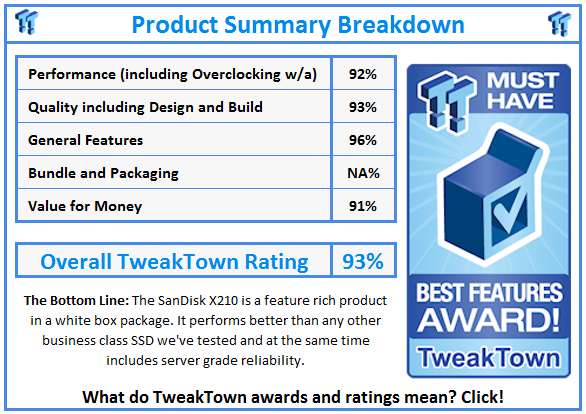Introduction
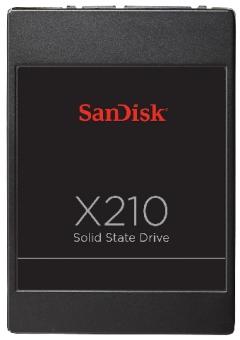
The fab companies and SSD manufacturers with NAND flash manufacturing capabilities are proactively reaching for market share. With arms extended out like a poker player sliding a pile of chips back to the stack, flash business is the ultimate game of Texas Hold'em.
By offering a large portfolio, once a company invests in one product, it's easier for the company to use other products from the same manufacturer. This reduces the cost of working with several manufacturers for support, logistics and custom firmware needs. SanDisk offers a large portfolio of products, a reach that goes far beyond just solid state drives. Flash-based storage has made inroads in markets we don't cover, like casino gaming machines and point of sale devices to name a couple.
The SanDisk X210 is a dual purpose SSD that fills two roles for businesses. The first is for notebook use where low power consumption, reliability and high performance are important. The second is for servers in a high read environment where read I/O takes priority, like server boot drives.
Today we're looking at the notebook side of the story and in a few days Paul Alcorn, TweakTown's enterprise storage editor, will publish a review on the enterprise workload performance.
Specifications, Pricing and Availability
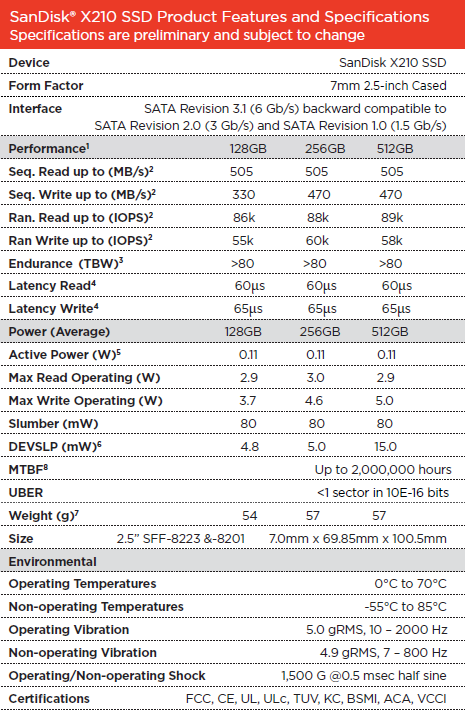
Available in three capacity sizes, the X210 is a little slower than the consumer specific Extreme II because more of the CPU is used to increase data integrity. Today we're testing the 256GB capacity size and the 512GB review will come out later. At 505 MB/s sequential read and 470 MB/s sequential write speeds, the X210 256GB is a strong performer in single drive SSD environments.
Unlike the other NAND flash used in SSDs now, SanDisk has yet to move to a 128Gb page size. The 16Gb page size on 19nm lithography is amazingly fast. In an age when SSDs are actually slowing down, SanDisk has managed to increase performance.
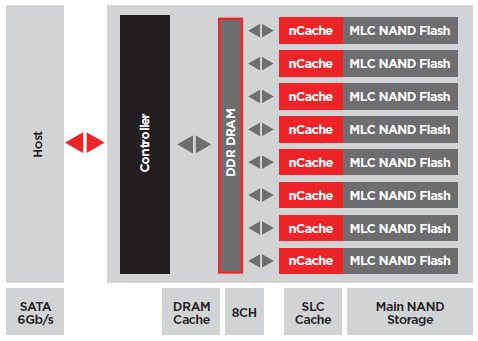
Introduced first on the Ultra Plus SSD, SanDisk's SLC layer built-in the MLC flash increases performance and does so in a nonvolatile way. The SLC area is dynamic in size and controlled by the Marvell controller that is also handles has a DRAM buffer to cache table data. SanDisk claims random 4K reads at 88K IOPS and random 4K writes at 60K IOPS.
The X210 product family also uses a new technology we've talked about off and on since CES and are very excited about - DEVSLP. On Haswell based notebooks and ultrabooks, DEVSLP reduces the power consumption of the SSD. SSDs are known for reducing power consumption over mechanical based storage, but DEVSLP extends the low power states. The trick is to keep resume times fast so the user doesn't notice a wake up event.
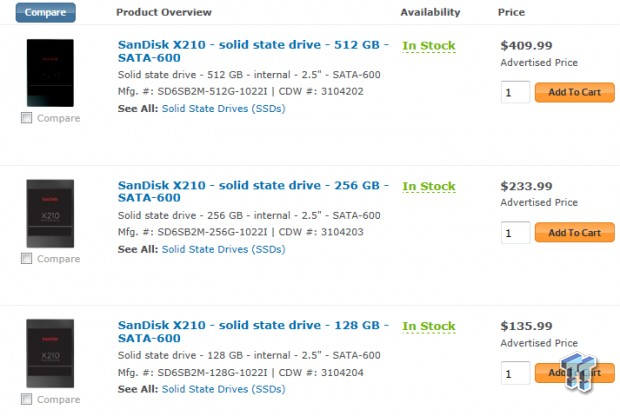
CDW has the X210, in all three-capacity sizes, in stock at the time of writing. The 256GB model we're looking at today costs less than $1 per GB, just $233.99. The X210 512GB is $409.99 and the 128GB is 135.99. These are OEM packaged drives, so they are sold as 'drive only'.
SanDisk X210 256GB SSD
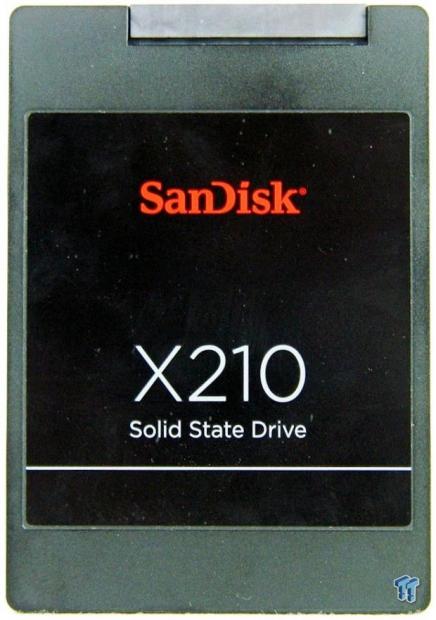
The X210 is a 2.5" SSD with a 7mm z-height. 7mm is the new standard for universal deployment because it fits new ultrabooks and is backwards compatible with existing notebooks, desktops and server drive sleds.
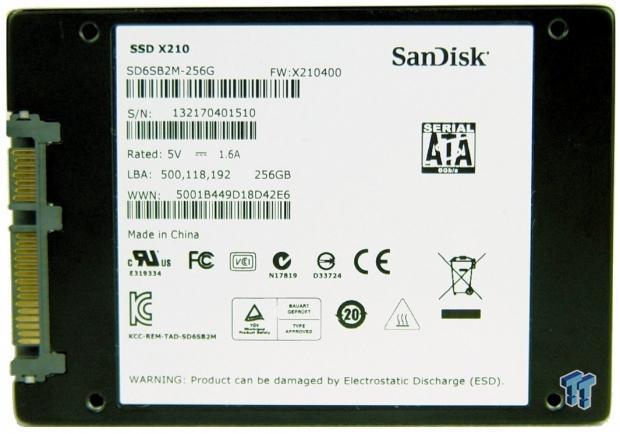
All of the mounting points on the bottom and sides are in the same positions as traditional 9.5mm 2.5" drives.


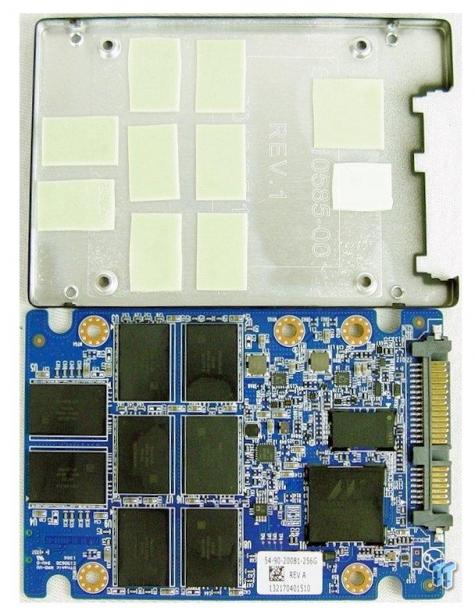
Inside the X210 we found thermal pads to transfer any heat from the flash, controller and DRAM buffer to the drive's case.
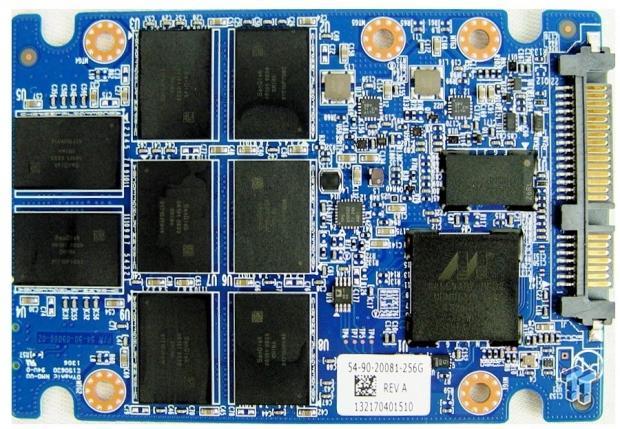
The Marvell controller uses an 8-channel design and the X210 uses eight NAND flash packages for storage.
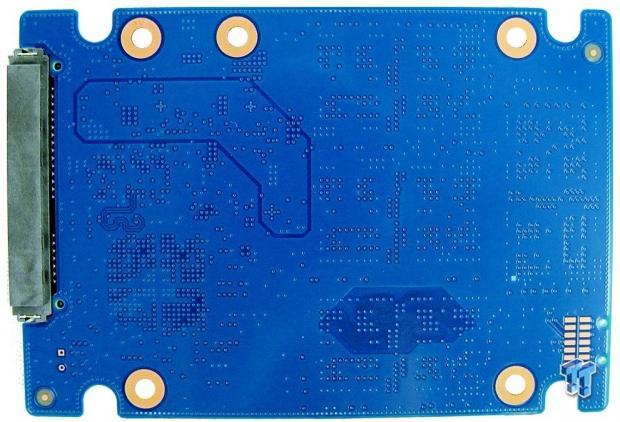
All of the surface mount components are on the primary side of the PCB. This allows the X210 to transfer heat directly to the metal side of the case.
Benchmarks - Test System Setup and ATTO Baseline Performance
Desktop Test System
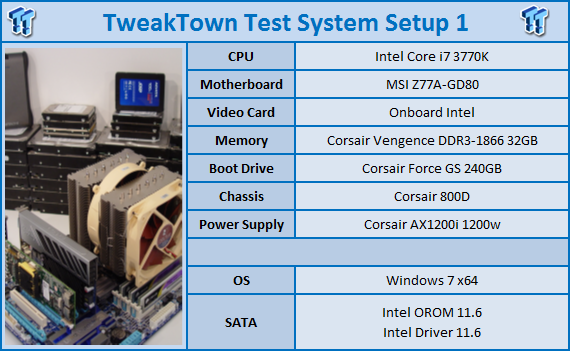
Lenovo W530 - Mobile Workstation
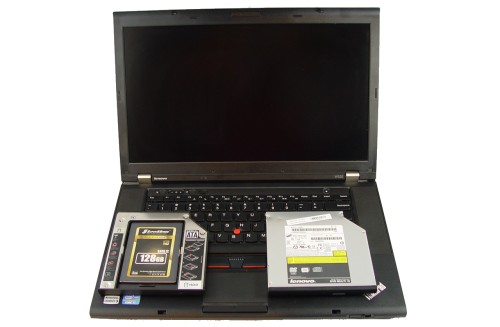
We use two systems for SSD testing. The desktop runs a majority of the tests and the Lenovo W530 runs the notebook power tests as well as the real-world file transfer benchmark.
ATTO Baseline Performance
Version and / or Patch Used: 2.34
ATTO is a timeless benchmark used to provide manufactures with data used market storage products.
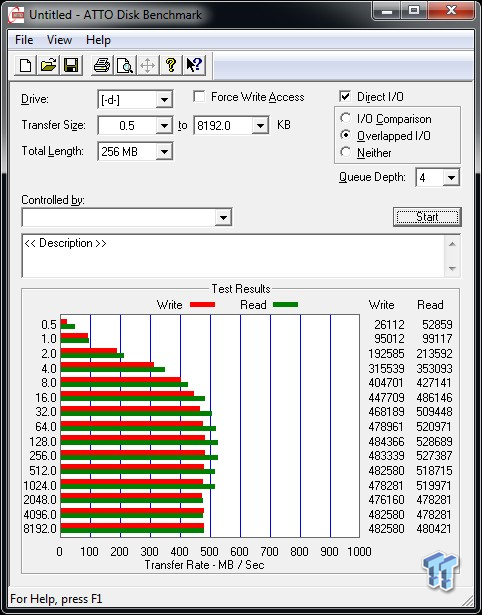
In our testing, we managed to pull more performance out of the X210 256GB than SanDisk claims on the specification sheet. This isn't anything new, SanDisk is always a bit conservative.
In ATTO with a queue depth of four, we achieved just under 530 MB/s read and 485 MB/s write.
Benchmarks - Sequential Performance
HD Tune Pro
Version and / or Patch Used: 4.00
Developer Homepage: http://www.efdsoftware.com
Product Homepage: http://www.hdtune.com
HD Tune is a Hard Disk utility which has the following functions:
Benchmark: measures the performance
Info: shows detailed information
Health: checks the health status by using SMART
Error Scan: scans the surface for errors
Temperature display
HD Tune Pro gives us accurate read, write and access time results and for the last couple of years has gained popularity amongst reviewers. It is now considered a must have application for storage device testing.
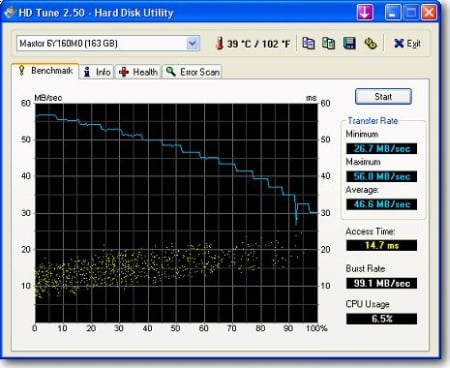
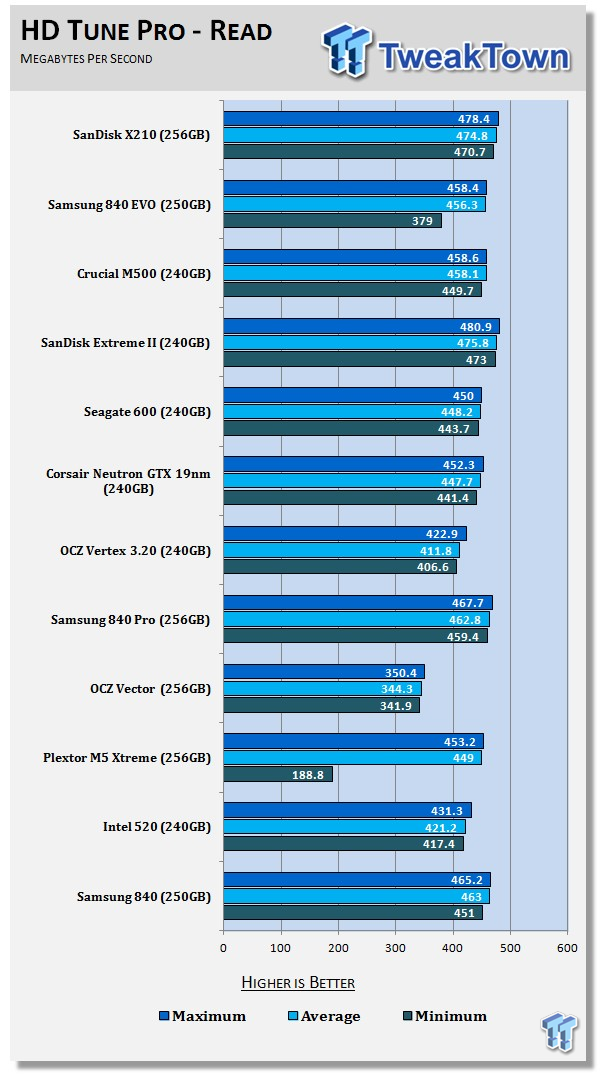
We expected the X210 to score a bit less than the Extreme II with the increased overhead for checks, but that wasn't the case for sequential reads. The X210's average sequential read of 474.8 MB/s is only 1 MB/s slower than the score of the Extreme II 256GB.
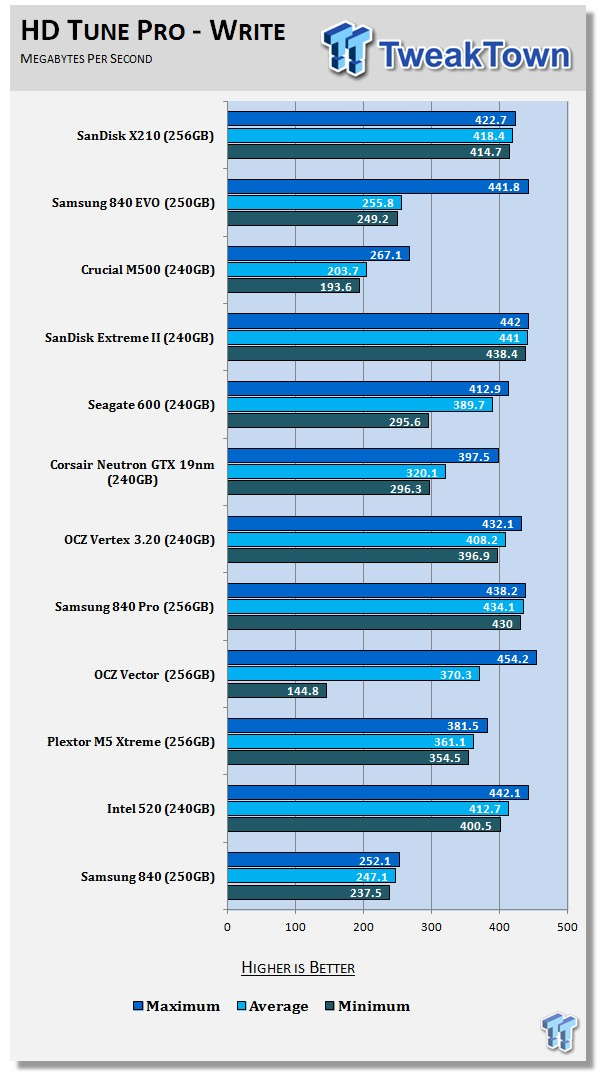
The sequential write performance is around 20 MB/s slower on the X210, but as you can see, the 418 MB/s sequential write speed is still very high when compared to the fastest consumer SSDs on the market today. The X210 still retains its same tight grouping between minimum and maximum performance though before getting hit with random writes.
HD Tach - Sequential Write Performance after Random Writes
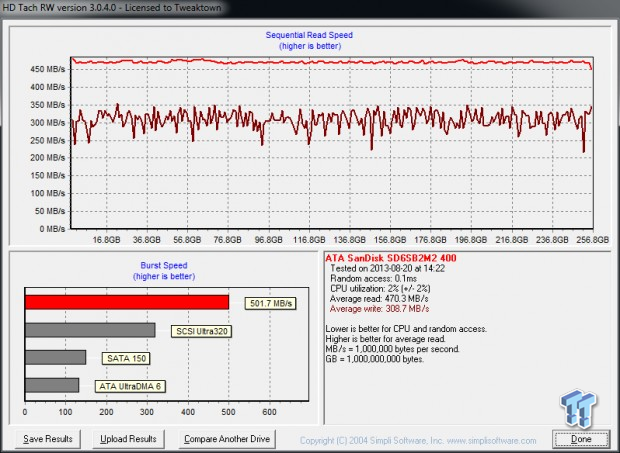
After peppering the X210 with a realistic amount of random writes for a client workload, the sequential write performance flutters, but doesn't drop to sub-100 MB/s levels like some of the other drives on the market today. This means your drive will still feel fast after heavy client use.
Benchmarks - AIDA64 Random Access Time
AIDA64 Random Access Time
Version and / or Patch Used: 1.60
Developer Homepage: http://www.aida64.com
Product Homepage: http://www.aida64.com
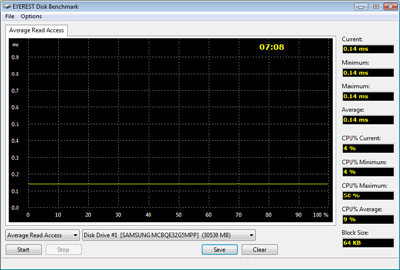
AIDA64 offers several different benchmarks for testing and optimizing your system or network. The Random Access test is one of very few if not only that will measure hard drives random access times in hundredths of milliseconds as oppose to tens of milliseconds.
Drives with only one or two tests displayed in the write test mean that they have failed the test and their Maximum and possibly their Average Scores were very high after the cache fills. This usually happens only with controllers manufactured by Jmicron.
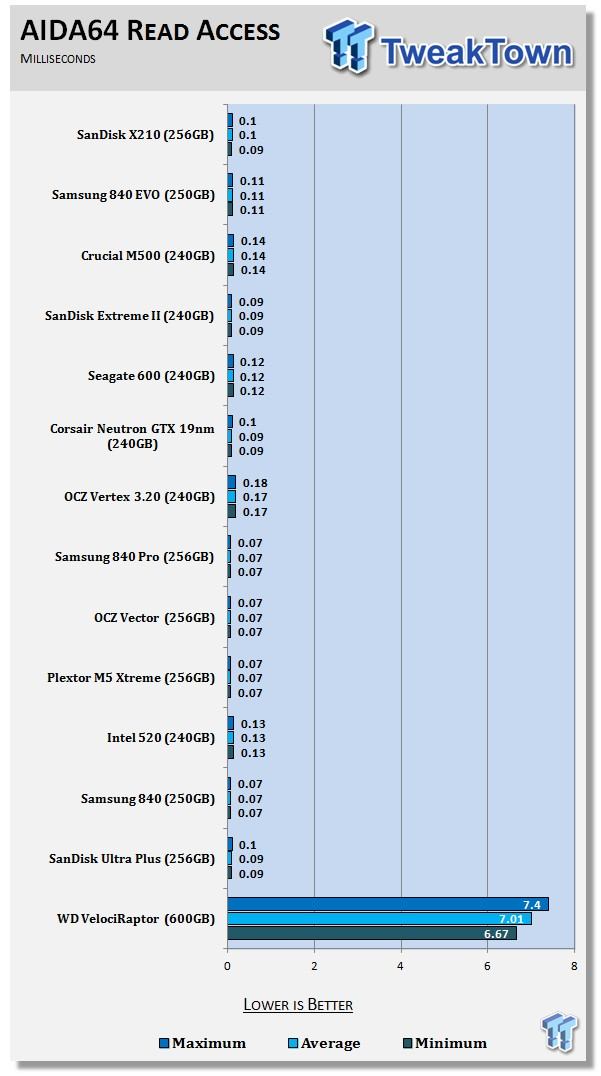
SanDisk still uses 64Gb page sizes so the latency is very close to the latency we scored with SanDisk's 24nm flash when reading data.

The write latency is a little higher on the X210 than what we scored with Extreme II. The CPU resource pie is only so large and when you dedicate more resources to one task, you need to remove resources from others. SanDisk moved some resources over to checking date integrity and we suspect the checks and the resources led to the higher latency. As you can see, the write latency is still very good, it's just a little higher.
Benchmarks - Anvil Storage Utilities
Anvil Storage Utilities
Version and / or Patch Used: RC6
So what is Anvil Storage Utilities? First of all, it's a storage benchmark for SSDs and HDDs where you can check and monitor your performance. The Standard Storage Benchmark performs a series of tests, you can run a full test or just the read or the write test or you can run a single test, i.e. 4K DQ16.
Anvil Storage Utilities is not officially available yet but we've been playing with the beta for several months now. The author, Anvil on several international forums has been updating the software steadily and is adding new features every couple of months.
The software is used several different ways and to show different aspects for each drive. We've chosen to use this software to show the performance of a drive with two different data sets. The first is with compressible data and the second data set is incompressible data. Several users have requested this data in our SSD reviews.
0-Fill Compressible Data
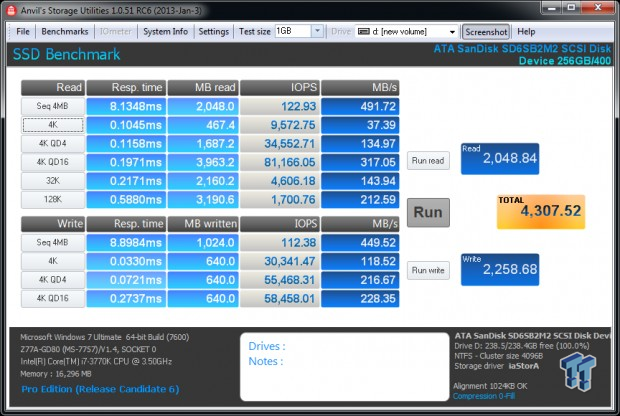
Incompressible Data
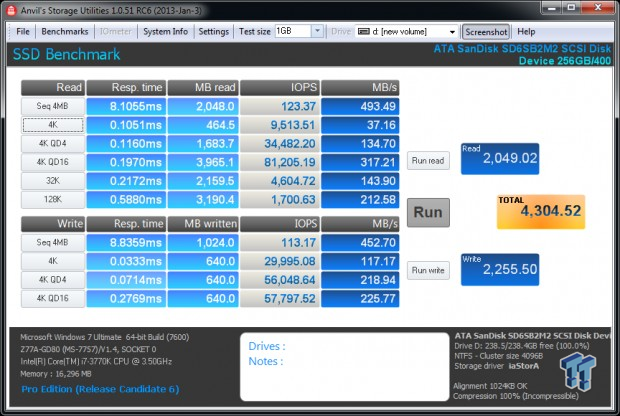
The X210 doesn't slow when working with incompressible data. We actually achieved a little better score when working with mixed mode, 46/54% than we did with 100% compressible or incompressible data.
Read IOPS through Queue Depth Scale
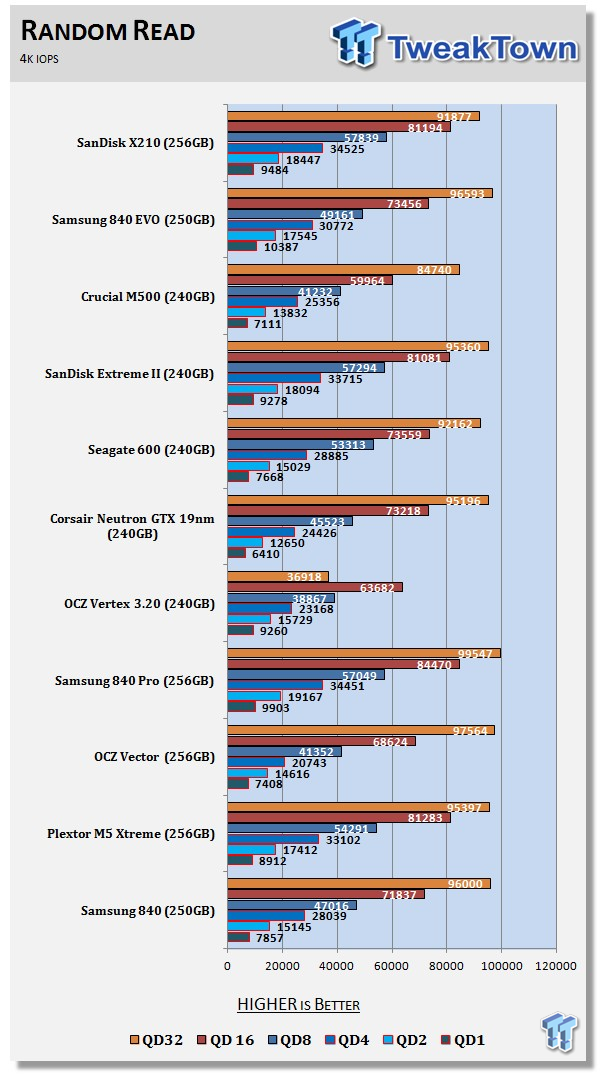
Looking at IOPS performance from a consumer load standpoint, the X210 does well at low queue depths. When used as a boot drive, you want high IOPS at low queue depths, since it's difficult to get high queue depths on the boot drive, unless you are running a number of applications at the same time.
Scaling Write IOPS through Queue Scale
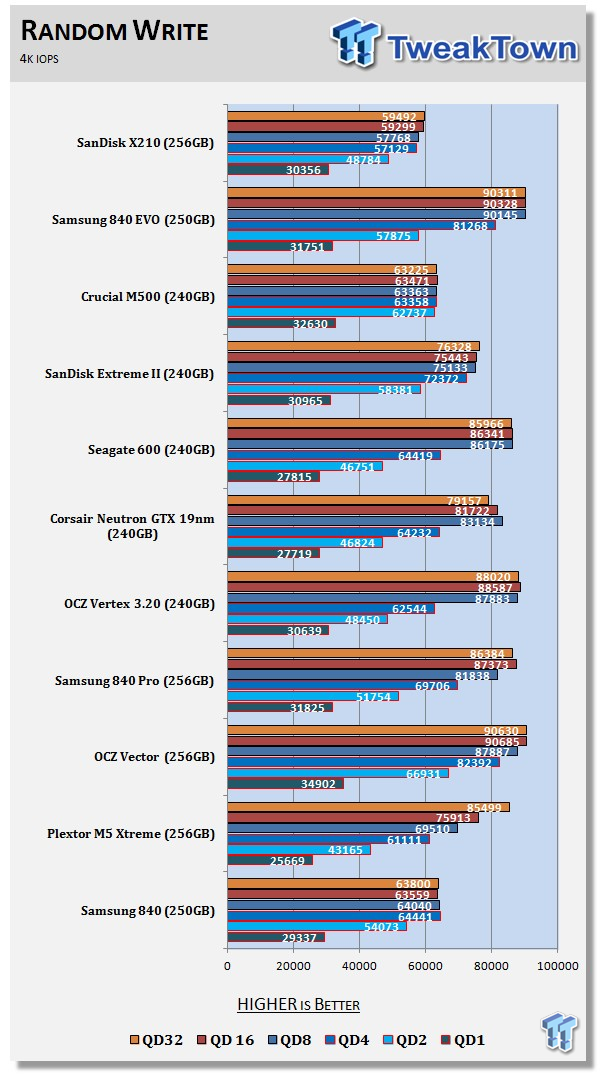
4K write IOPS performance at QD1 was around 30,000 and that scaled to 48,000 at QD2. Everything between QD4 and QD32 was around 60K, 15K less than the Extreme II. SanDisk didn't release the X210 as an enthusiast part like the Extreme II, yet both are designed for operating systems.
Benchmarks - CrystalDiskMark
CrystalDiskMark
Version and / or Patch Used: 3.0 Technical Preview
Developer Homepage: http://crystalmark.info
Product Homepage: http://crystalmark.info/software/CrystalDiskMark/index-e.html
Download here: http://crystaldew.info/category/software/crystaldiskmark
CrystalDiskMark is a disk benchmark software that allows us to benchmark 4K and 4K queue depths with accuracy.
Key Features:-
* Sequential reads/writes
* Random 4KB/512KB reads/writes
* Text copy
* Change dialog design
* internationalization (i18n)
Note: Crystal Disk Mark 3.0 Technical Preview was used for these tests since it offers the ability to measure native command queuing at 4 and 32.
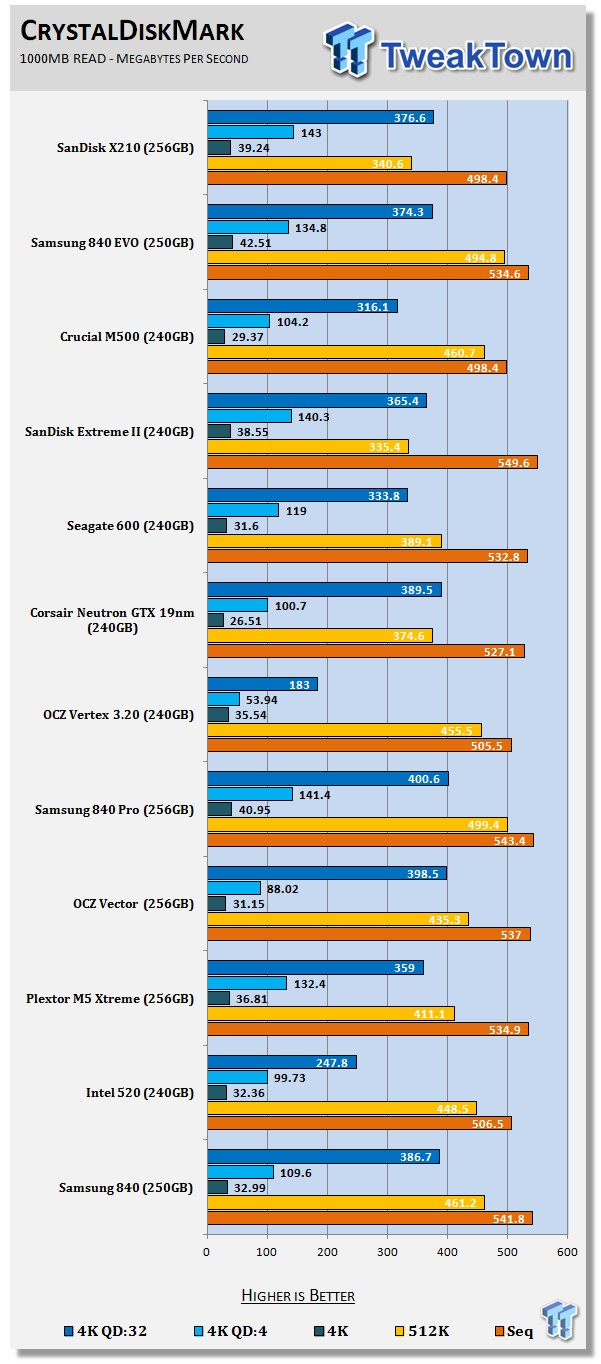
Very few client SSDs manage to break 40 MB/s 4K QD1 and the X210 wasn't one of them. It would be difficult to get any closer, though, without going over the line. When looking at megabytes per second, the X210 scales well when going from QD1 to QD4. The sequential test showed nearly 500 MB/s when using incompressible data.
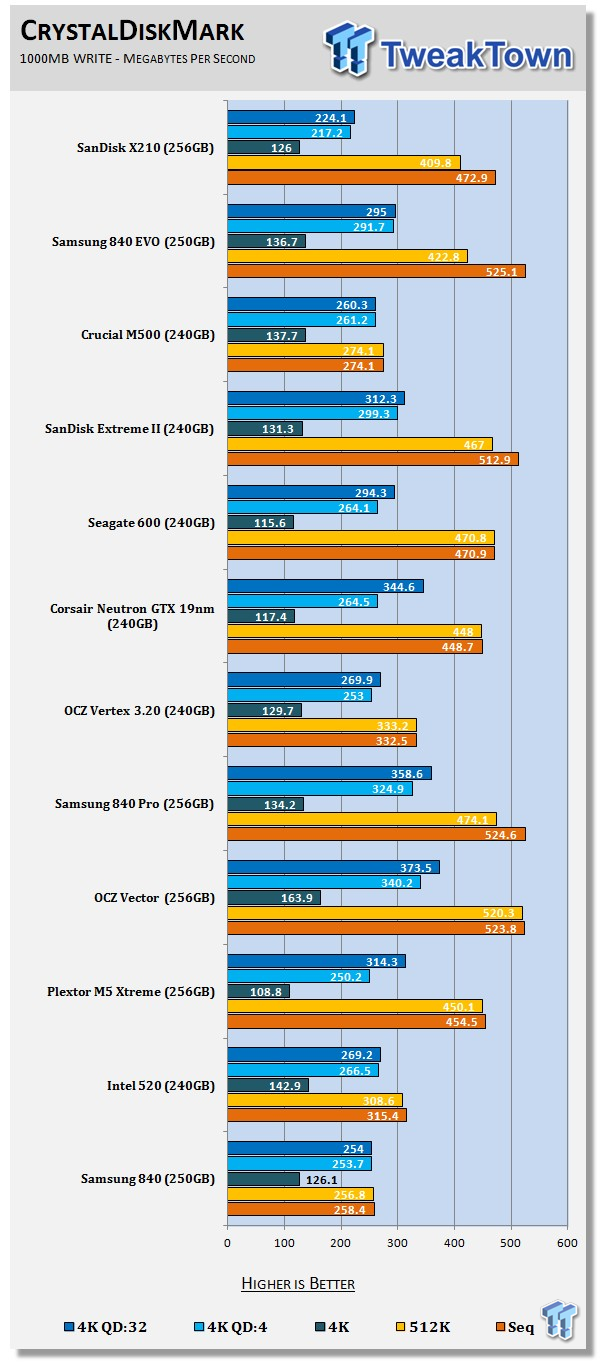
There is not much to say when it comes to incompressible data writes. The X210 delivers good performance, while keeping data secure.
Benchmarks - PCMark Vantage Hard Disk Tests
PCMark Vantage - Hard Disk Tests
Version and / or Patch Used: 1.0.0
Developer Homepage: http://www.futuremark.com
Product Homepage: http://www.futuremark.com/products/pcmarkvantage

PCMark Vantage is the first objective hardware performance benchmark for PCs running 32 and 64 bit versions of Microsoft Windows Vista. PCMark Vantage is perfectly suited for benchmarking any type of Microsoft Windows Vista PC from multimedia home entertainment systems and laptops to dedicated workstations and high-end gaming rigs. Regardless of whether the benchmarker is an artist or an IT Professional, PCMark Vantage shows the user where their system soars or falls flat, and how to get the most performance possible out of their hardware. PCMark Vantage is easy enough for even the most casual enthusiast to use yet supports in-depth, professional industry grade testing.
FutureMark has developed a good set of hard disk tests for their PCMark Vantage Suite. Windows users can count on Vantage to show them how a drive will perform in normal day to day usage scenarios. For most users these are the tests that matter since many of the old hat ways to measure performance have become ineffective to measure true Windows performance.

HDD1 - Windows Defender
HDD2 - Gaming
HDD3 - Windows Photo Gallery
HDD4 - Vista Startup
HDD5 - Windows Movie Maker
HDD6 - Windows Media Center
HDD7 - Windows Media Player
HDD8 - Application Loading
The SanDisk X210 256GB is a beast running real-world applications on a fresh drive. None of the individual tests win, but the drive delivers solid performance in each test.
Benchmarks - PCMark Vantage - Drives with Data Testing
For a complete breakdown on the Drives with Data Testing please read this article. You will be able to perform this test at home with the files provided in the article - full instructions are included.
- Brief Methodology
SSDs perform differently when used for a period of time and when data is already present on the drive. The purpose of the Drives with Data testing is to show how a drive performs in these 'dirty' states. SSDs also need time to recover, either with TRIM or onboard garbage collection methods.
Drives with Data Testing - 25%, 50%, 75% Full States and Dirty / Empty Test
Files needed for 60 (64GB), 120 (128GB), 240 (256GB)
60GB Fill - 15GB, 30GB, 45GB
120GB Fill - 30GB, 60GB, 90GB
240GB Fill - 60GB, 120GB, 160GB
Empty but Dirty - a test run just after the fill tests and shows if a drive needs time to recover or if performance is instantly restored.

With data on the X210, the performance slows considerably, but the affect is universal for SSDs.
Benchmarks - BootRacer
BootRacer - System Boot Time
Version and / or Patch Used: 4.0
Developer Homepage: Greatis
Product Homepage: BootRacer
Download here: http://www.greatis.com/bootracer/download.htm
Note: In this test we use the Lenovo W530 Mobile Workstation loaded with an operating system and several program files. The data on the drive at the time of the test is 45GB. The second test, 50GB Free, was ran with the drives filled with block data until only 50GB of free capacity remained.
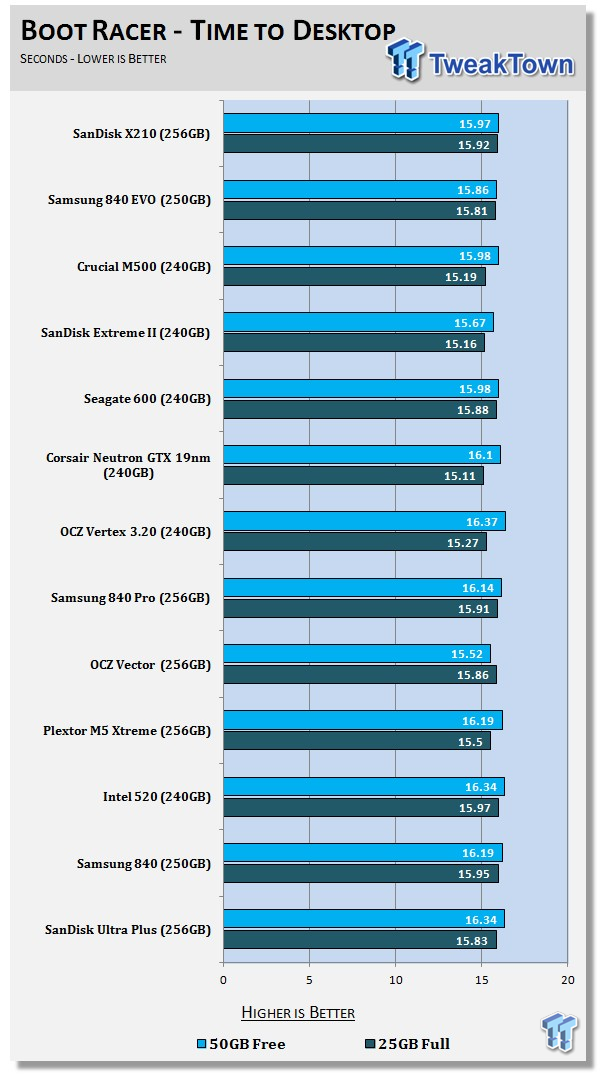
Once the drive gets populated with data, it doesn't lose a lot of performance. In this test, we measure the system reboot time to desktop with 25GB of data on the drive and 206GB of data on the drive. The time to desktop time didn't change a lot in our Lenovo W530.
Benchmarks - DiskBench
DiskBench - Directory Copy
Version and / or Patch Used: 2.6.2.0
Developer Homepage: Nodesoft
Product Homepage: DiskBench
Download here: http://www.nodesoft.com/diskbench/download
Note: In this test we use the Lenovo W530 Mobile Workstation and a SuperSSpeed S301 SLC 128GB SSD to move a 15GB block of data to and from the target drive. This is part of our real-world test regiment. Roughly 45GB of data resides on the target drive before the '15GB Block' is transfer. The 15GB Block is the same data we built for the Data on Disk Testing and is a mix of compressible and incompressible data.
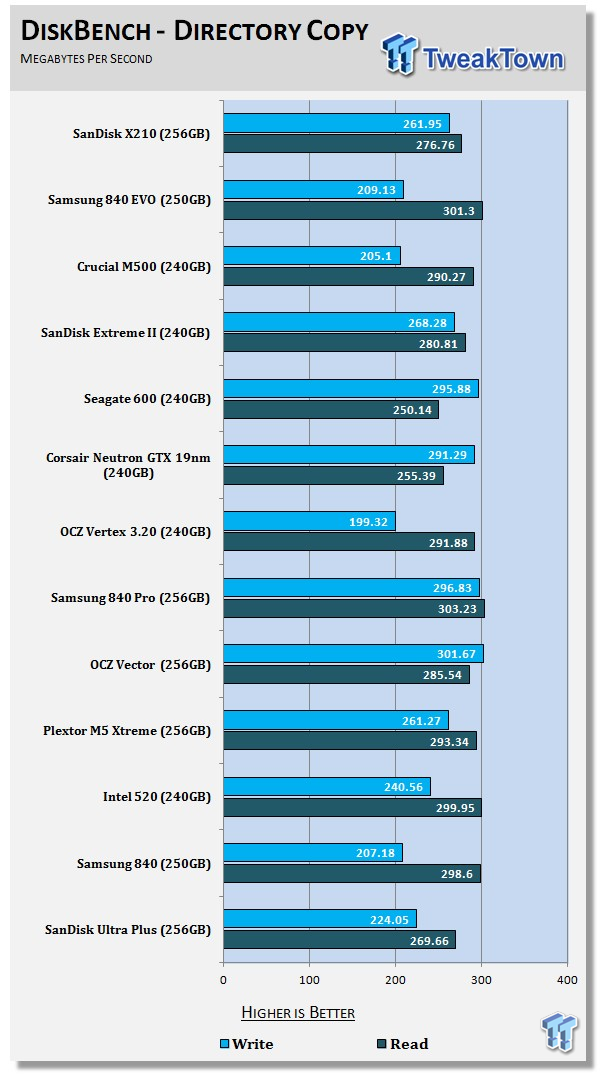
The X210 256GB performs really well when transferring data. The chart has several purpose built SSDs for the enthusiast market and the X210 runs with them in this and many other tests.
Benchmarks - Power and Thermal Testing
Bapco MobileMark 2012 1.5
Version and / or Patch Used: 2012 1.5
Developer Homepage: http://www.bapco.com
Test Homepage: http://www.bapco.com
MobileMark 2012 1.5 is an application-based benchmark that reflects usage patterns of business users in the areas of office productivity, media creation and media consumption. Unlike benchmarks that only measure battery life, MobileMark 2012 measures battery life and performance simultaneously, showing how well a system design addresses the inherent tradeoffs between performance and power management.
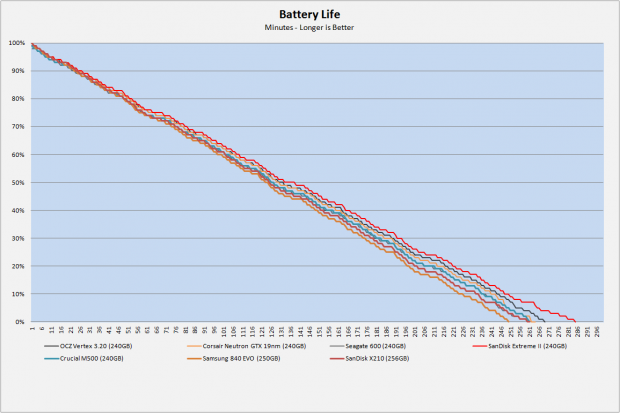
The Lenovo W530 that we use for notebook battery life has an Ivy Bridge processor in it so it can't take advantage of DEVSLP. Intel has been slow to roll out new ultrabooks and notebooks with Haswell and that's why we've yet to update our test platform.
With the understanding that this test does NOT currently use the full capabilities of the technology the X210 has to offer, the drive delivers an average amount of battery life.
PCMark Vantage HDD Test - Power Draw
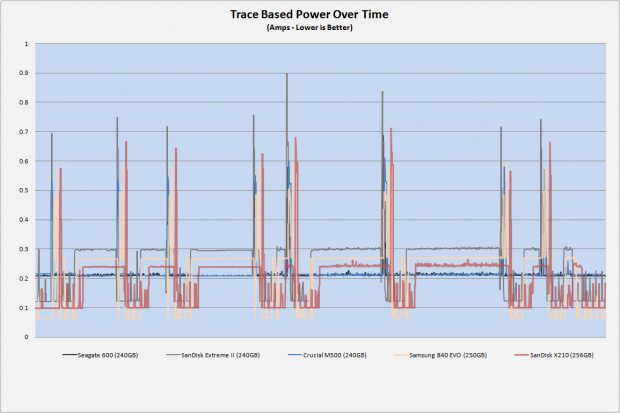
Despite the average performance in our battery life test, the X210 doesn't use a lot of power when performing tasks with daily use software, even without DEVSLP working.
Thermal Test - Beta
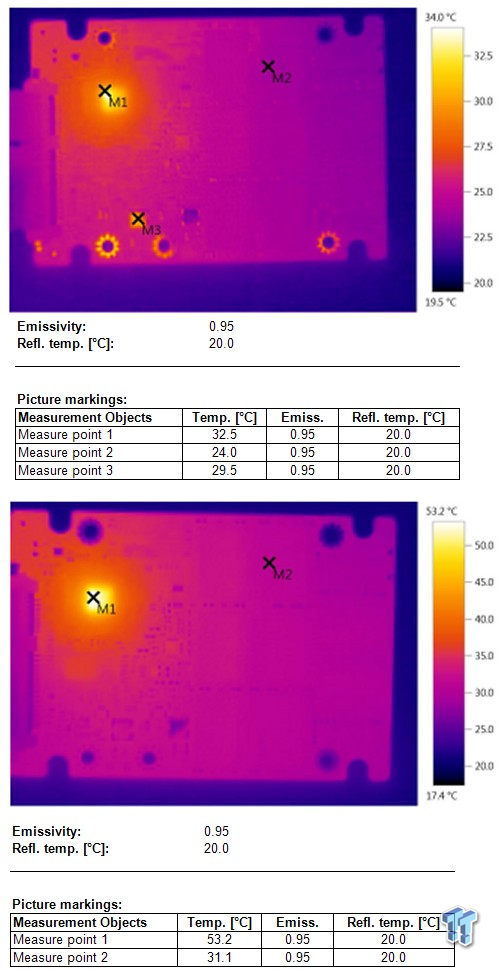
Here we see the SanDisk X210 at idle for 10 minutes and under a 4K IOMeter load for 10 minutes. We've tested several Marvell controllers under load with our thermal imager and the X210 produced the best thermals to date.
Under load, the controller only gets to 53.2C. The PCB does a good job of spreading the heat out evenly so the flash endurance shouldn't suffer from heat issues.
Final Thoughts

Since we use two test labs for evaluating client and enterprise features, the enterprise tests will follow next week by Paul Alcorn. SanDisk has high hopes for this dual purpose product and designed in features that we have yet to discuss. Unlike the Extreme II, X210 users get the full capacity of the drive. This way end users can set the amount of over provisioning they need. On the client side, 7% is a good starting point for heavy use, but when applying server loads, some will find that 28% is better, especially for high write environments.
SanDisk has essentially taken the quality of the Extreme II up a notch when it comes to data reliability and traded a small portion of performance. At the same time, the X210 gives access to the full span of the flash and added the advanced power saving features from DEVSLP.
The result is a drive better suited for business use than the enthusiast grade Extreme II. Windows 8.1 should hit on October 17 and we expect a lot of news about Haswell ultrabooks with DEVSLP capabilities at that stage. Until then, we won't try to guesstimate the increase in notebook battery life performance, but given the power numbers SanDisk is quoting, it should be a significant upgrade.
On the performance side, the X210 is the best OEM SSD I've tested to date. We've tried to run through every SSD that comes in a notebook from the big box guys - Lenovo, Dell, HP and so on - when we have the opportunity.
Part of SanDisk's vertical approach is to increase the number of products shipping with high performance SSDs. This will have an impact on aftermarket sales, but in the end, customers get great performance right out of the box, without going through the upgrade hassle.

